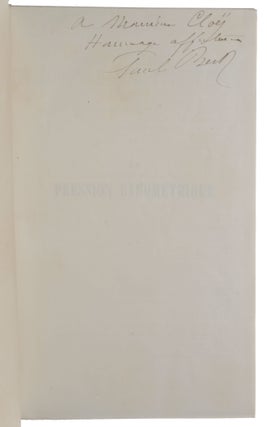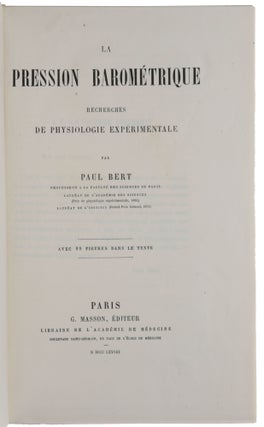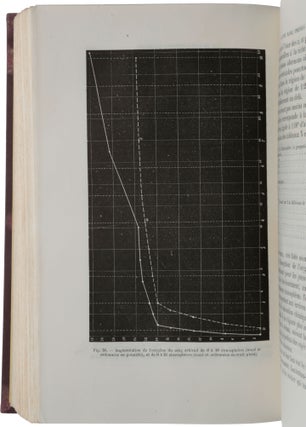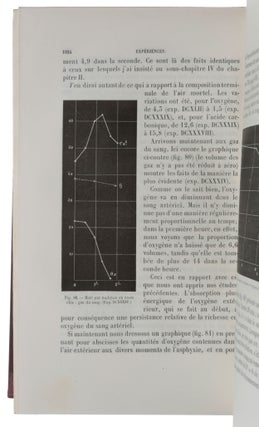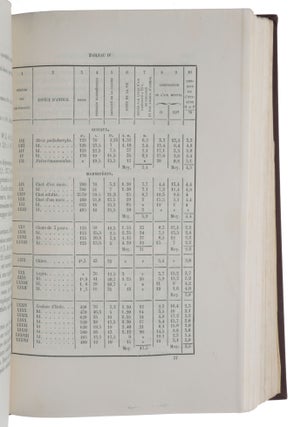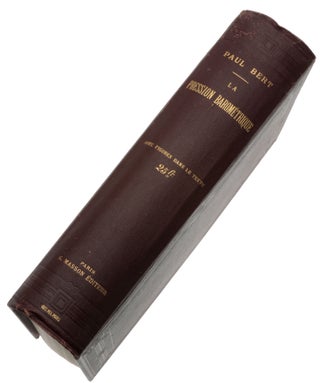La pression barometrique.
Paris: Masson, 1878. First edition, very rare in commerce, inscribed author’s presentation copy, and an exceptionally fine copy, of Paul Bert’s classic work, which marks the foundation of the study of altitude physiology. In this work, “Bert proved that the principal symptoms of altitude sickness arise from reduced partial pressure of oxygen and not from diminution of total pressure. Bert introduced oxygen apparatus to avert the dangerous consequences of ascent to high altitudes, and was the first to study the conditions of high-altitude ascents in a pressure chamber. He also explained the aetiology and mechanism of caisson disease. One of Bert’s examiners for the licentiat was Claude Bernard who was so impressed with Bert’s abilities that he invited him to become his laboratory assistant. In 1868 Bert was the successor of Claude Bernard’s chair at the Sorbonne, Bernard having resigned to leave it vacant for him. It was in Paris that he carried out the fundamental studies on the effects of different partial pressures of oxygen upon the respiration of animals which laid the foundations for aviation medicine. It is tragic that the chaos of a far-flung war was required to bring Bert’s work into its full meaning and perspective … Paul Bert began to work actively on respiratory problems early in the seventies, and in 1878 he published La pression barometrique, a book which stands at the very cornerstone of modern altitude physiology … The first 522 pages deal with the history of altitude physiology up to that date; and if Paul Bert did nothing else, we should be lastingly in his debt for this masterly historical presentation – a model, be it said, for any student wishing to write in the field of medical history. The second part, occupying 518 pages, contains experimental protocols; the third and final part, which runs to 118 pages, contains his resumé and conclusions, and is again a model of concise, orderly and logical scientific presentation” (Fulton). “In March 1874, Crocé-Spinelli and Sivel, who had served as subjects in Bert’s experiments, accompanied by a physician, ascended to 23,000 feet in a balloon and came down safely. On April 15th Crocé-Spinelli and Sivel, accompanied this time by Gaston Tissandier, decided to make a second ascent to a greater height. Since Bert was away from Paris, Crocé-Spinelli wrote to tell him of their plans. Bert realized immediately what would happen and wrote to warn them, but his letter arrived too late. On April 15th the men ascended to 26,300 feet. All lost consciousness, and Tissandier alone survived the catastrophe” (Hagströmer Library). Bert’s researches on the physiological effects of air pressure gained him the Academie des Sciences biennial prize of 20,000 francs in 1975, and paved the way for later researchers such as Christian Harald Bohr (father of Niels), K.A. Hasselbalch and A.S. Krogh, who demonstrated the nature of the oxygen ‘dissociation curve’ in 1904 (see Garrison-Morton 726). ABPC/RBH list only two copies, an ex-library copy (Swann, Oct 18, 2005, lot 45), and a copy purchased by Meyer Friedman at Sotheby’s in 1963. Provenance: Inscribed by Bert on the front flyleaf: ‘A Monsieur Cloij[?Cloéj?Cloÿ?] hommage affectueux Paul Bert’ (we have not been able to identify the recipient). Born at Auxerre, Paul Bert (1883-86) studied law, earning a doctorate in Paris; then, under the influence of the zoologist Louis Pierre Gratiolet, he took up physiology, becoming one of Claude Bernard’s most brilliant students. After graduating at Paris as doctor of medicine in 1863, and doctor of science in 1866, he was appointed professor of physiology successively at Bordeaux (1866) and the Sorbonne (1869). “It was to Claude Bernard that Bert owed his greatest debt. As a student and collaborator of Bernard, he became acquainted with the methods of experimental physiology, the critical evaluation of experimental findings, and the attempt to describe the basic laws of physiology. Bert was deeply impressed by Bernard’s concept of an internal environment …Through all his scientific work we can perceive the constant endeavor to study the phenomena of life in the context of the exterior and interior environment … “In 1870 Bert published an important work dealing with problems of the comparative physiology of respiration. This monograph was based on his lectures delivered at the Muséum d’Histoire Naturelle, Paris, in the spring semester of 1868. Bert analyzed the anatomical structures and the physiological functions of the respiratory organs of vertebrates and invertebrates. He also dealt with the problem of tissue respiration and showed that the oxygen content of the blood depended on the exterior air pressure. The respiratory movements of aquatic and air-breathing animals were investigated with novel methods and techniques. He studied the nervous regulation of the respiratory rhythm and investigated the respiration of diving animals. He analyzed the death mechanism of asphyxia and succeeded in clearly differentiating true asphyxia caused by lack of oxygen from carbon dioxide poisoning. This work, rich in facts and new views, also provided a critical evaluation of a vast number of problems. “Bert’s definitive work, La pression barométrique, published in 1878, represented an environmental study on the largest scale. The great questions were: How does the changing exterior milieu—the atmospheric Pressure—act on an organism? What are the effects of low pressure at high altitudes? How does the high pressure to which the caisson worker [diver] is exposed affect the body? How does the blood, the interior milieu, behave under high and low pressures? What is the mechanism of mountain sickness? Bert’s interest in these problems arose early in his scientific work. In 1864, while a student of Bernard, he had discussed the question of whether the amount of gases dissolved in the blood depended on atmospheric pressure. The French physician Denis Jourdanet, who had practiced in Mexico and was interested in the biological and medical aspects of high-altitude climates, provided Bert with the necessary means to build the costly apparatus needed for the experimental study of the physiological effects of air pressure. Jourdanet had constructed pressure chambers for therapeutic use and had formulated the hypothesis that the blood contained less oxygen under the low atmospheric pressure of high altitudes, a condition he called barometric anoxemia. “In his first series of experiments Bert studied the following problem: What extremes of air pressure can a living being endure? He first examined the effects of low pressure and found that animals died after the partial pressure of oxygen sank below a critical level that was constant for each species. Bert therefore announced the following principle: Oxygen tension is everything; barometric pressure in itself does nothing or almost nothing. “Bert then studied the physiological effects of pure oxygen or air inhaled under high pressure: the dogs used died with tonoclonic cramps. Thus he discovered the phenomenon of acute oxygen poisoning and was able to state that if the organism receives too little oxygen, it suffocates; and if it is exposed to oxygen at high pressure, it is poisoned. In a second series of experiments he studied the behavior of blood gases under various pressures. These investigations relied on the fundamental studies of blood gases made by Carl Ludwig and his students. Bert found: ‘The combination of oxygen with hemoglobin is likely to be partially destroyed, to be dissociated at low pressures…. Everything seems to indicate that there exists in the neighborhood of normal pressure a point of chemical saturation of the oxyhemoglobin, and that beyond this point there is added to the blood only oxygen dissolved in the serum according to Dalton’s law.’ “Bert also experimented on himself in the pressure chamber in order to study the effects of low atmospheric pressure on the human body. When the pressure was decreased to 400 millimeters of mercury, he noted increased pulse rate, headache, dizziness, darkening of the vision, mental lassitude, and nausea. These complaints disappeared as soon as he inhaled oxygen. Bert also trained balloonists in his pressure chamber and provided them with oxygen bags for their flights to high altitudes. He recognized that when the partial pressure of oxygen is reduced, the altitude sickness of the aviator, the mountain sickness of the alpinist, and the complaints encountered in low pressure experiments appear. Bert also clarified experimentally the mechanism of decompression sickness (caisson disease). Sudden decompression from high atmospheric pressures (five-ten atmospheres) produced gas bubbles in the blood and tissues. These gas bubbles consisted primarily of nitrogen that had previously been dissolved under high pressure and was liberated by the decompression. Bert emphasized that the duration of compression was of great importance. As prophylaxis for caisson disease he devised a slow, gradual decompression; treatment was recompression and low decompression. “The results of Bert’s monumental work were manifold: He fully realized the physiological importance of the partial pressures of the respiratory gases. He described the relationship between the external partial pressure and the behavior of the blood gases. He recognized that mountain sickness and altitude sickness are a consequence of the low partial pressure of oxygen. He introduced oxygen apparatus to avert the dangerous consequences of ascent to high altitudes. He was the first to study in a pressure chamber the conditions of high-altitude ascents. He discovered and described oxygen poisoning, and explained the cause and mechanism of caisson disease … “In La pression barométrique Bert discussed the problem of acclimatization to high altitudes. Is the blood of individuals at high altitudes capable of absorbing more oxygen than the blood of individuals living at sea level? Three possibilities might be conceived: a qualitative change in the hemoglobin, an increase in the hemoglobin content of the red corpuscles, or an increase in the number of erythrocytes. Starting from Bert’s hypothesis that people living at high altitudes might possess more red corpuscles, François Viault examined human and animal blood in the Peruvian Andes from 1890 to 1892. He observed on himself and on his companions that the number of erythrocytes increased from 5,000,000 to 7,000,000 within three to five weeks. This important fact, which showed a substantial change of what is normally a biological constant, initiated the systematic high-altitude research in the Alps (conducted by Hugo Kronecker, A. Mosso, and others)” (DSB). Garrison-Morton 944; Fulton, Selected Readings in the History of Physiology, p. 141-142 and pl. 25; Grolier, One Hundred Books Famous in Medicine, 77; Norman 218; En Français dans le Texte, 305; Fulton, Aviation Medicine (1948), pp. 35-40; Hoff & Fulton, Bibliography of Aviation Medicine (1942), p. 227; Jones, The Ins and Outs of Breathing, p. 132.
8vo (240 x 153 mm), pp. [viii], viii, 1168, with 89 text illustrations, uncut and unopened. Original publisher’s maroon cloth stamped in gilt and blind (very slight wear along hinges and at extremities). A very fine copy, internally bright and fresh.
Item #5284
Price: $12,500.00


